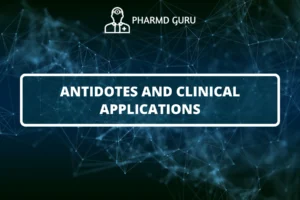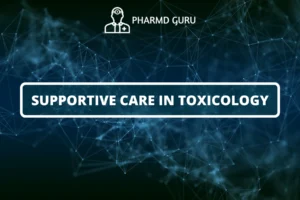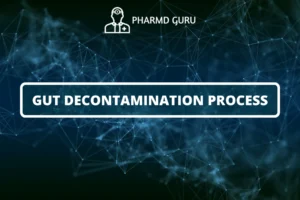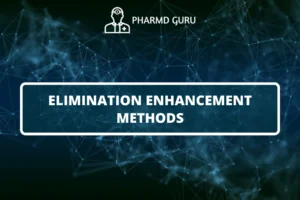General principles involved in the management of poisoning is a topic in Clinical toxicology, which covers: Introduction to Toxicology, clinical toxicology, General principles involved in the management of poisoning, which are 1. Stabilizations 2. Evaluation 3. Decontamination 4. Poison Elimination 5. Antidote Administration 6. Nursing and Psychiatric Care.
SCROLL DOWN TO THE BOTTOM OF THE PAGE FOR ACTUAL NOTES
TABLE OF CONTENTS:
- Introduction
- Recognizing Poisoning
- Immediate Steps to Take
- Contacting Emergency Services
- Assessing the Victim
- First Aid Measures
- Preventing Further Exposure
- Decontamination Techniques
- Medical Treatment and Monitoring
- Supportive Care and Symptom Management
- Poisoning Prevention Strategies
Introduction
Poisoning is a serious medical emergency that occurs when a person is exposed to toxic substances. It can happen through ingestion, inhalation, absorption, or injection of harmful substances. Managing poisoning cases requires prompt and appropriate action to minimize the impact on the victim’s health. This article outlines the general principles involved in the management of poisoning, providing valuable insights on recognizing poisoning, immediate steps to take, first aid measures, medical treatment, and preventive strategies.
Recognizing Poisoning
The first step in managing poisoning is to recognize the signs and symptoms. Poisoning can manifest in various ways depending on the type and amount of toxin involved. Common indications include nausea, vomiting, dizziness, difficulty breathing, seizures, altered mental state, and skin rashes. It is crucial to be aware of the potential sources of poisoning, such as household chemicals, medications, plants, and venomous animals, to quickly identify the cause.
Immediate Steps to Take
When you suspect poisoning, swift action is essential. Follow these immediate steps to assist the victim:
- Assess the Situation: Ensure your own safety and assess the environment for any ongoing hazards.
- Remove the Victim from the Source: If the poisoning occurred due to exposure to a toxic substance, move the person away from the source to prevent further harm.
- Call for Help: Dial the emergency services hotline in your country to report the incident and seek professional assistance. Provide them with essential details, such as the victim’s condition, the suspected toxin, and your location.
Contacting Emergency Services
Contacting emergency services promptly is crucial in managing poisoning cases. Emergency medical responders are trained to handle toxic exposures and can provide immediate guidance on the necessary steps to take. When reaching out to emergency services, remain calm and provide clear and concise information. Follow their instructions carefully while waiting for medical professionals to arrive.
Assessing the Victim
While waiting for medical help, assess the victim’s condition to gather vital information that can assist healthcare providers. Pay attention to the person’s level of consciousness, breathing rate, and any visible symptoms. This assessment can aid in determining the severity of poisoning and guide subsequent treatment decisions.
First Aid Measures
Proper first aid measures can significantly impact the outcome of a poisoning incident. Here are some general guidelines to follow:
- Maintain Airway, Breathing, and Circulation: If the victim is unconscious and not breathing, start cardiopulmonary resuscitation (CPR) immediately, if you are trained to do so. Ensure a clear airway and initiate rescue breathing if necessary.
- Remove Contaminated Clothing: If the toxin is on the victim’s skin or clothing, remove any contaminated items to prevent further absorption.
- Rinse Affected Areas: If the poisoning occurred due to contact with a chemical or substance, rinse the affected areas with copious amounts of water unless otherwise specified by medical professionals.
Preventing Further Exposure
To minimize the risk of additional exposure to the toxic substance, follow these steps:
- Isolate the Area: If the poisoning occurred in a confined space, ensure the area is well-ventilated and evacuate non-essential personnel.
- Handle Substances Safely: Use personal protective equipment, such as gloves and goggles, when handling toxic substances to prevent self-exposure.
- Secure the Source: If the poisoning resulted from a household product, medication, or other substances, secure the source to prevent accidental ingestion or contact by others.
Decontamination Techniques
Decontamination aims to remove or neutralize the toxic substance from the victim’s body. The specific technique depends on the route of exposure. Here are common decontamination methods:
- Skin Decontamination: For skin exposure, rinse the affected areas with water for at least 15 minutes. Use mild soap if available but avoid scrubbing, which can increase absorption.
- Eye Irrigation: If the eyes are exposed to a toxin, flush them with a gentle stream of clean water for at least 15 minutes, ensuring proper eyelid separation.
- Ingestion or Inhalation: In cases of ingestion or inhalation, do not induce vomiting or administer any substances without professional guidance. It is best to wait for medical professionals to provide appropriate treatment instructions.
Medical Treatment and Monitoring
Once the victim receives medical attention, healthcare providers will evaluate the situation and initiate necessary treatments. These may include:
- Activated Charcoal: Administered in some cases to absorb toxins from the digestive system.
- Gastric Lavage: In certain situations, gastric lavage (stomach pumping) might be performed to remove the ingested toxin.
- Antidotes: Specific antidotes may be given to counteract the effects of particular toxins.
- Monitoring and Support: Healthcare providers will continuously monitor vital signs, blood tests, and other relevant parameters to ensure the victim’s stability and administer appropriate supportive care.
Supportive Care and Symptom Management
During the recovery phase, supportive care is essential for managing poisoning cases. This may involve:
- Fluid and Electrolyte Replacement: Maintaining adequate hydration and electrolyte balance is crucial, especially in cases involving vomiting or diarrhea.
- Control of Symptoms: Medications or treatments may be provided to alleviate specific symptoms, such as antiemetics for nausea and analgesics for pain relief.
- Psychological Support: Some cases of poisoning can have long-term psychological effects. Ensuring emotional support and counseling services are available can aid in the victim’s recovery.
Poisoning Prevention Strategies
Preventing poisoning incidents is key to safeguarding individuals and communities. Consider the following strategies:
- Safe Storage: Keep toxic substances out of reach of children and store them in locked cabinets or secure areas.
- Proper Disposal: Dispose of expired medications, household chemicals, and other toxic materials according to local regulations.
- Education and Awareness: Educate yourself and others about the potential risks of toxic substances and the appropriate precautions to take.
- Childproofing: Implement childproofing measures in homes and environments frequented by children, including safety latches on cabinets and child-resistant closures on containers.
ACTUAL NOTES




